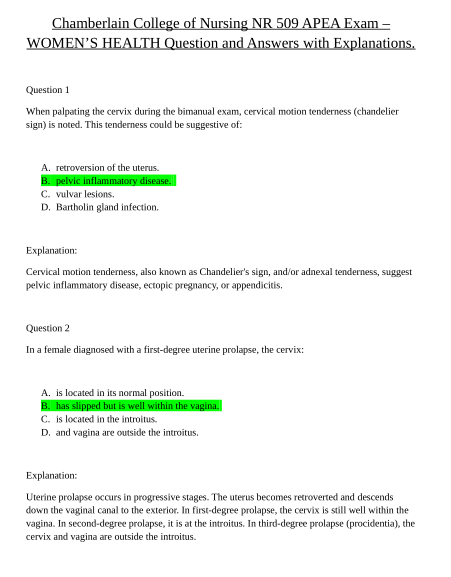Chamberlain College of Nursing NR 509 APEA Exam –
WOMEN’S HEALTH Question and Answers with Explanations.
Question 1
When palpating the cervix during the bimanual exam, cervical motion tenderness (chandelier
sign) is noted. This tenderness could be suggestive of:
A. retroversion of the uterus.
B. pelvic inflammatory disease.
C. vulvar lesions.
D. Bartholin gland infection.
Explanation:
Cervical motion tenderness, also known as Chandelier’s sign, and/or adnexal tenderness, suggest
pelvic inflammatory disease, ectopic pregnancy, or appendicitis.
Question 2
In a female diagnosed with a first-degree uterine prolapse, the cervix:
A. is located in its normal position.
B. has slipped but is well within the vagina.
C. is located in the introitus.
D. and vagina are outside the introitus.
Explanation:
Uterine prolapse occurs in progressive stages. The uterus becomes retroverted and descends
down the vaginal canal to the exterior. In first-degree prolapse, the cervix is still well within the
vagina. In second-degree prolapse, it is at the introitus. In third-degree prolapse (procidentia), the
cervix and vagina are outside the introitus.
Question 3
Daughters of women who took Diethylstilbestrol (DES) during pregnancy are at a high risk for
developing all of the following abnormalities except:
A. columnar epithelium covering most or all of the cervix.
B. a slit- like cervical os.
C. vaginal adenosis.
D. a circular collar or ridge of tissue between the cervix and the vagina.
Explanation:
Daughters of women who took Diethylstilbestrol (DES) during pregnancy are at greatly
increased risk for several abnormalities: columnar epithelium that covers most or all of the cervix
vaginal adenosis, and a circular collar or ridge of tissue, of varying shapes, between the cervix
and vagina. The slit-like cervical os is a normal variation.
Question 4
A female patient presents with a profuse, yellowish, green vaginal discharge that is malodorous.
This vaginal discharge is most consistent with:
A. candidal vaginitis.
B. bacterial vaginosis.
C. Trichomonal vaginitis.
D. gonorrhea.
Explanation:
Trichomonas vaginalis causes trichomonal vaginitis. Presenting symptoms include a profuse,
yellowish, green vaginal discharge that is malodorous. Candidal vaginitis produces a white and
curd-like thin discharge that is rarely malodorous. With bacterial vaginosis, the discharge can be
gray or white, thin, malodorous (fishy), and not usually profuse. The discharge associated with
gonorrhea is usually thick and bloody.


